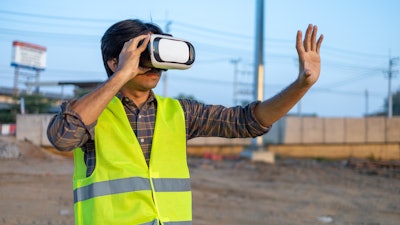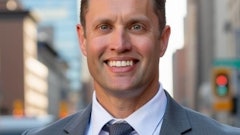
The construction industry employs nearly 8 million people in the U.S. as of August 2022. Recent statistics show that the industry continues to grow, with more than 32,000 jobs added in July of this year. Despite setbacks with labor shortages, material price hikes and supply chain disruptions, construction spending on buildings is projected to increase by over 9 percent this year and another 6 percent in 2023, according to the American Institute of Architects. With so many people employed in construction, it is no wonder that safety is the No. 1 concern at construction jobsites.
The Occupational Safety and Health Administration (OSHA) cites that falls account for the most significant number of fatalities in the construction industry. “Struck-by” incidents are listed as the fourth biggest cause of injuries at jobsites, and more than 75 percent of these involve heavy equipment. While most construction firms follow safety protocols and regulations to minimize risk and injury, accidents will still happen.
Construction zones pose a danger to anyone who enters the area. On any jobsite, construction workers move around the site on foot. Workers must dodge equipment speeding through the site carrying loads of aggregate, cement or other heavy materials. The heavier the equipment is at the site, the more probability there is for injury of a worker walking through the site.
If a person wanders through a construction zone while distracted, they can easily be injured. Many sites have few roads for equipment to travel on, so a person could easily walk in front of a truck or be sideswiped by it. Drivers may not see an individual walking in front of their truck. Or the driver may have to swerve to avoid pedestrians and wrecking the vehicle. Many construction firms are turning to technology to reduce risk and accidents.
Sensor Technology in Construction
Technology in the form of IoT devices, such as telematics equipment or wearable sensors, can help reduce accidents. These devices provide information on a location where equipment and staff are located at all times, in real-time. Construction managers can know at any instance where a piece of equipment or a worker is positioned. If workers are in a dangerous area, they can be notified that they need to move. If a piece of equipment is where it shouldn't be, managers can see where the equipment is and determine whether it has been stolen or used by an unauthorized person.
Telematics Devices
Telematics devices are embedded in heavy equipment, allowing contractors to monitor the location of a piece of equipment and verify speed, driver safety, and equipment health. Telematics incorporates GPS positioning to track equipment location, fuel usage, engine speed, and other meter readings. By incorporating this data into construction equipment tracking software, contractors eliminate the double-entry of information, which can lead to errors. Telematics devices follow geofences so that equipment stays within the boundaries of the jobsite.
With telematics, construction companies can see if their employees are driving and operating equipment safely and prevent loss or theft by receiving alerts when equipment is used during odd times or moved off the job site. Managers can be alerted and deal with issues on the spot if an employee is driving recklessly.
Schedule preventative maintenance based on usage and adjust the usage to avoid unnecessary runtime. Maintenance management systems can configure preventative maintenance alerts to track when a piece of equipment needs to undergo routine maintenance. When a piece of equipment is coming in for an oil change, management can schedule time in advance to handle any other issues identified through reports from the field.
Preventative maintenance can be hard to track and lead to poor equipment utilization. Maintenance management systems easily keep track of maintenance schedules, so equipment is appropriately maintained. Properly maintained equipment reduces downtime and keeps equipment in the best shape possible. Well-oiled machines mean safer equipment, too.
Wearable Technologies
Wearable technology can help construction workers do their jobs safely. Wearables can warn management when workers are close to a danger zone on the jobsite. Wearables come in a variety of options. They can track the workers' health while also tracking productivity. Construction firms must determine which wearables should be used to achieve specific goals. Top safety wearables include:
- Smartwatches: Track health and activity; some can send alerts and offer hands-free communication. Other smartwatches can detect falls and dial emergency operators on the workers' behalf. Still, others can track the worker in a map view so that management will know where the worker is on the jobsite. Smartwatches allow construction workers to communicate hands-free, such as sending messages that they have fallen and must be rescued.
- Smart Boots: Like smartwatches, can track a worker's movements while walking around a jobsite. The boots feature internal and external sensors for receiving and sending alerts, such as calls for help if the worker is injured or alerts that the worker is in an unsafe area. Sensors in the sole of the boots can detect falls. One vendor offers a safety pod that attaches to any boot or shoe.
- Smart Hard Hats: These hard hats look like any other hard hat, except they have embedded smart sensors that monitor workers’ movements and surroundings. They can send an alert in the event of danger, while sensors in the hat share information about the workers’ location. Some smart hats can measure vital signs to detect whether a worker is overly heated or too fatigued. Proximity sensors in heavy equipment and hard hats can alert supervisors and workers to potential collisions. One construction firm used a smart hat to trace where a COVID-infected worker had worked and whom he had interacted with.
- Augmented Reality (AR) Glasses: Most jobsites require workers to wear safety glasses; AR glasses are the next generation. Future smart glasses offer the same benefits as a smartphone, only hands-free. Smart glasses can reduce accidents by flashing warnings about objects, materials, or areas that should be avoided. AR smart glasses can be used in training, giving instructions on operating equipment while workers perform those operations. Smart glasses are also being combined with Building Information Modeling (BIM) tools so workers can walk through a jobsite and check progress against the BIM model.
- Smart Monitor: These can be worn on parts of the body to track dangerous gases, monitor temperatures, check heart rates, and more. Sensors around the chest detect body temperature and can alert workers when they need to take a break. Other monitors can detect dangerous gases and alert workers as to potential exposure. Wearable safety monitors collect valuable data, such as movement, noise levels, and air quality, while the worker is wearing them. If the worker makes a dangerous movement, they will be alerted.
- Smart Gloves: Are new in the market and help wearers correctly perform tasks. Some smart gloves have embedded scanners in the fingertips to relay the correct part or tool to use in a repair. If the worker has picked up the wrong tool, they receive vibration feedback that alerts them to their mistake.
Using the Internet of Things, construction firms can improve the safety of their workers and the jobsite.




















